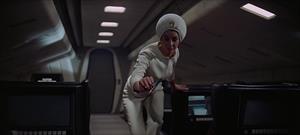| 1 2 3 4 |



Many of the 2001 craft have windows showing the crew. Different techniques were used, including front projection carefully matted onto the spaceship image. 1999 used a simpler technique, with a foreground photograph on glass with the astronauts seen through the glass. 2001 also used photographs of models, and of the lunar landscape, rather than filming the models directly. Planets were back-lit transparencies of artwork, or, for the Moon, astronomy photographs, techniques also used for 1999.



The lunar mountains seen in 2001 are steep and jagged. Without atmosphere and water (and volcanoes and plate tectonics), it seemed logical that the mountains of the moon would be more rugged. When the Apollo 15 mission landed close to Mons Hadley on the moon, it showed a very rounded profile. Space: 1999 show the more rounded lunar mountains. Although there are more craggy mountains on the moon, most are relatively rounded. Lunar mountains are not formed by plate tectonics and intense water erosion, they were formed by huge collisions with comets and asteroids in the early solar system, literally melting the rock. They have been eroded by micrometeorites over billions of years, and lunar quakes from nearby meteorite strikes. The jagged appearance of mountains on Earth is directly caused by water erosion and tectonics. Here 1999 is more accurate.


The special effects technicians on 2001 spent months hand-rotoscoping mattes for the spacecraft passing through space. For 1999, Brian Johnson used just a few stars in specific areas of the frame, quickly and easily avoiding that effort. Audiences had recently watched the Apollo landings, and shots of NASA spacecraft, and knew the lunar sky was black with almost no stars. In space, like on Earth, you cannot see stars in daylight. The light of the sun is too bright, and the stars too dim. Only when the sun is hidden behind the Earth (or Moon) can the stars be seen, In night, of course, the spaceship would also be in intense darkness, a dark silhouette against the stars. If it had window lights, that light would drown out the nearby stars. All science fiction films now follow the strong directional, high contrast lighting of spaceships established by 2001 and 1999. 1999 is one of the few to have realistically spartan stars.
The other problem with stars in the film, and every science fiction film ever, is that they are moving at all. They are light years away, and unless the spaceship is moving at a high proportion of the speed of light across vast distances of the galaxy, they would appear static. Only if the ship (or camera) is turning would the stars seem to move. Because we are used to seeing the scenery move behind cars, trains or planes, audiences expect the stars to move to indicate movement.



2001 only attempts to show zero gravity outside the spaceship, in the airlock scene, and in the computer core. There is one celebrated scene with the pen floating in the cabin (attached to a foreground plate of glass), but the stewardess is walking with velcro slippers. There is no attempt to make them float through the ship. The space station rotates to provide simulated gravity, as does the inner wheel section of the Discovery spaceship (12m in diameter). Strangely, the pod bay also seems to have gravity, and there is no attempt to simulate lower gravity on the moon. Centripetal "gravity" helps to reduce muscle and bone deterioration in weightlessness (although it may cause nausea). The velcro slippers don't give any health benefits, but might put a lot of tension on the ankles to keep the body orientated. Few films have attempted to simulate weightlessness; one of the first to achieve it was Gravity (2013).
| 1 2 3 4 |
Space: 1999 copyright ITV Studios Global Entertainment
2001 A Space Odyssey copyright MGM
Text copyright Martin Willey